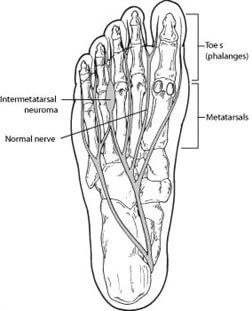Neuroma

 Neuroma is the condition that occurs with the thickening of nerve tissue that may develop in various parts of the body. The most common Neuroma is a Morton's Neuroma, which occurs between the third and fourth toes. Often known as an intermetatarsal Neuroma, "Intermetatarsal" describes its location in the ball of the foot between the metatarsal bones. Neuroma may also occur in other parts of the foot. Neuroma (MortonThe thickening) or enlargement, of the nerve often caused by the compression and irritation of the nerve. This leads to the enlargement of the nerve, eventually leading to permanent nerve damage.
Neuroma is the condition that occurs with the thickening of nerve tissue that may develop in various parts of the body. The most common Neuroma is a Morton's Neuroma, which occurs between the third and fourth toes. Often known as an intermetatarsal Neuroma, "Intermetatarsal" describes its location in the ball of the foot between the metatarsal bones. Neuroma may also occur in other parts of the foot. Neuroma (MortonThe thickening) or enlargement, of the nerve often caused by the compression and irritation of the nerve. This leads to the enlargement of the nerve, eventually leading to permanent nerve damage.
Causes
Although even experts are not able to figure out the exact causes of Neuroma, any kind of compression or irritation leads to the condition. One of the most common causes of Neuroma is wearing shoes that have a tapered toe box, or high-heeled shoes. Certain foot deformities such as bunions, hammertoes, flatfeet may also led to the higher risk of developing Neuroma. Other potential causes of Neuroma include; activities that involve repetitive irritation to the ball of the foot, such as running or court sports. An injury or other type of trauma to the area may also lead to a Neuroma.
Symptoms of Neuroma
One of the most common symptoms of Neuroma is pain in the inter-space between the third and fourth toe. The pain could be sharp or dull, and the condition becomes worse by wearing shoes and walking. However, the pain is usually less severe if the body weight is on the lower side.
Patient diagnosed with Morton's Neuroma generally complain of tingling, burning, or numbness, pain. In some cases, patients might also feel like there is something inside the ball of the foot. Morton's Neuroma often follows the same pattern. For instance its symptoms begin gradually and the pain is felt only sometimes like while wearing narrow-toed shoes or performing certain aggravating activities. The symptoms become worse over time and may persist for several days or weeks even if you avoid walking.
Diagnosis
Doctors normally diagnose the Neuroma by reading the patient's medical history. The doctor may also check for Neuroma by pressing into the foot's affected inter-space. Under severe conditions, patients may also need to undergo an X-Ray to check if there are any fractures or Arthritis. MRI scan may also be requested to rule out tumours and determine the size of the Neuroma.

